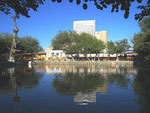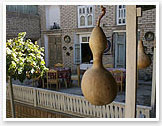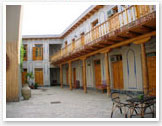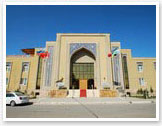 |
| source: narod.ru |
In the center of Bukhara there is the small artificial pond, which over 4 centuries serves as the place of recreation for visitors and residents of Bukhara. In ancient times, the territory of Bukhara had a lot of ponds that supplied the population with water, but in the beginning of the XX century due to the spread of diseases through water, many ponds were drained and filled up. But Labi-Hauz, which means "the shore of pond", has been preserved thanks to the buildings around him.
The history of creating the pond dates back to the depth of legends. Once the noble vizier of Bukhara, Nadir Divan Begi decided to dig a pond in front of khanqah, which still stands before it. But that time, on the site of pond it was the house of a lonely Jewish woman, who did not want to sell it. Divan-Begi tried to resort to his authority, but the Emir of Bukhara sent him to the Mufti Council, who resolved that the land could not be taken from the Jewish woman by force, since she paid taxes to preserve her religion, and therefore could act on a par with Muslims. Then the wily vizier had dug aryk along the walls of her house, and the water gradually began to undermine the foundation. Jewish woman wanted to complain, but eventually they settled the dispute peacefully: the Jewish woman gave the land for the pond, and Divan-Begi gave her the part of his land to build the first synagogue in Bukhara.
Now the pond, with the depth of 5 meters and with the area of 42 by 36 meters, is surrounded by age-old trees, in the shade of which people have a rest. As far back as hundred years ago water-carriers walked down the limestone steps, surrounding the pond, to use the water for very different purposes: drinking, irrigation and construction.
The architectural complex, surrounding the famous pond consists of Kukeldash madrassah, built in 1569, madrassah and khanqah named in honor of Nadir Divan-Begi. Madrassah and khanqah facing each other and separated by the pond, were built in 1620-1623.
The largest (80 by 60 meters) not only in Bukhara, but also throughout Central Asia, madrassah Kukeldash represents the ambiguous approach to the erection of magnificent building. On the one hand, the construction is made by the new project, in which the open balconies were on the outer wall, and floral designs on tiles of blue, green and white colors decorated it. On the other hand, negligence and saving, with which the building was erected, led to the fact that today it is fastened with strainers and backed by load beams.
And madrassah, which was built by the vizier Nadir Divan-Begi, originally was intended as a caravanserai, but the Emir of Bukhara Imam Quli Khan at the inauguration announced the new building as madrassah, and the Vizier had to build the second floor with cells, corner towers and the main portal.
Opposite this madrassah there is the khanqah (house for dervishes), which was built at the same time as the Divan-Begi Madrassah. It represents the multi-cell building in the center of which there is the domed hall, from which small niches lead.
This ensemble is not only the architectural monument of XVI-XVII centuries, but also the wonderful place of rest from the midday heat in the shade of ancient plane trees.







